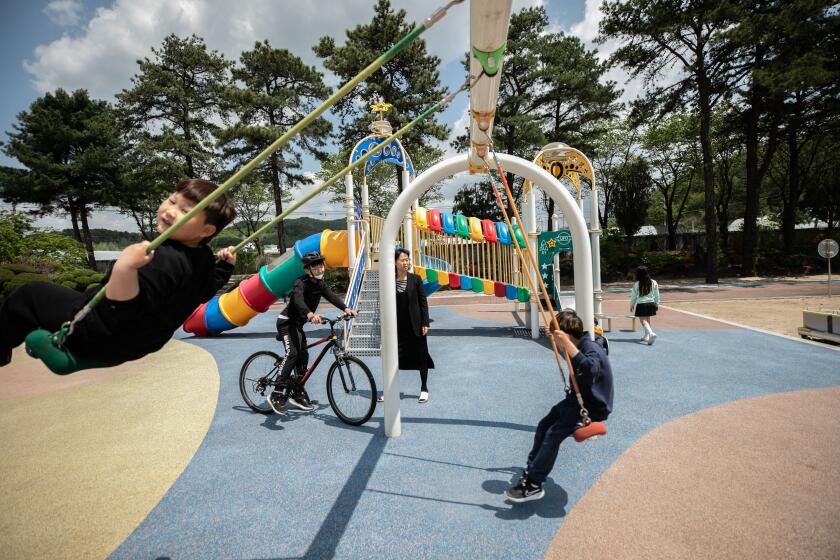Dispensing Counsel, Correctives in the Service of Justice for Youngsters
Judge Patricia Reardon smiles as she reads the greeting card that falls onto her desk from a stack of files. Then she sighs and sets it aside.
“I always save the thank-you notes from my kids,” she says.
On this particular day, her kids are 21 abused or neglected children and juvenile delinquents. Some are charged with crimes that would send adults to prison for years. Others are victims of crimes. One was raped by her brother.
All are making their way through the state’s juvenile justice system, and Reardon hopes they’ll be better for it when they leave her courtroom. “I love my kids,” she says.
At home and on the bench, Reardon, 46, is a mom: full-time for her 9-year-old daughter, and part-time for the troubled children whose cases she hears.
“It’s no different from parenting,” she says of her job. “What matters is how you’re punishing.”
By 9:30 a.m., Reardon already has heard three adoption cases. Awaiting her are several cases of assault, three burglaries and a handful of children needing protection, counseling or other state care.
Outside the courtroom, a dozen teenagers stare at the floor while their parents pace. Their hearings are due in 15 minutes, but it will be more like 30.
She likes to make them wait, Reardon says, to give everyone involved a chance to strike a deal, one she hopes is in the best interests of all.
Nearly 10,000 children moved through the state’s juvenile justice system in 1997. More than 7,100 were delinquents charged with crimes, ranging from petty theft to rape. The rest were abused, neglected or in need of help from the state. New Hampshire juvenile court records are sealed, so no names can be published.
Appointed nine years ago, Reardon is a part-time judge with a full-time caseload. Like most women with motherhood as a job, she gets no vacation, no benefits, and works more than 50 hours a week. She earns about $35 an hour.
“What could be more important?” she asks. “What could you do on a daily basis that’s more important?”
The bailiff announces a 15-year-old with a history of running away and skipping school. Reardon grabs a stack of files as she dons her black robe and hurries out of her chambers.
“Does my hair look OK? I’m having a terrible bad hair day,” Reardon says in a flurry of robe and paper.
It is the teenager’s second appearance. A few months earlier, her mother asked Reardon to declare her a “child in need of services,” making her eligible for state care.
Reardon’s message at the time, of taking responsibility, seems to have sunk in.
“I heard a rumor that Mom wants to withdraw the petition,” Reardon says to the mother and daughter before her. The daughter nods and smiles.
“She’s doing much better,” her mother answers. “If I tell her to be home, she is. There aren’t even any swear words used in the house anymore.”
Reardon nods and offers some advice. “We use a cup at my house, and if a swear word comes out, you have to put money in it.”
The mother withdraws the petition.
Off the bench, Reardon hesitates to say youth crime is getting worse but admits at least 25% of her children are what she calls “frequent flyers.”
“They’re kids,” she says, shrugging. “You look at some of the things they do, and maybe you did some of those things too. But . . . they don’t know where to draw the line.”
What’s lacking, she says, is accountability. Too many children act without thinking, without digesting what they are doing. She tries to make up for some of that.
“Oftentimes I’ll ask the kids to tell me what happened,” she says. “That way they acknowledge what they did wrong.”
Law wasn’t Reardon’s first career, but nurturing was always a mainstay. She worked as a nurse for seven years until her health prompted her to find a less physically demanding job. She graduated from Boston’s New England School of Law in 1983.
Reardon now patches emotional wounds. A 16-year-old shuffles into the courtroom and slumps into a chair. He turns his head to watch his mother sobbing at the back of the room.
The youngster is in court to plead “true” (the juvenile equivalent of guilty) to simple assault on his girlfriend.
Reardon is not happy. At his last appearance, she told him to stay in school and out of trouble. He did neither.
The kid tries to play it cool, but his voice cracks as he stands and tells Reardon he hadn’t meant to bite the girl on her stomach. Reardon doesn’t buy it.
“The minute she says no, it means no,” she scolds. “You have to learn that.”
The assault, along with a history of school truancy and a true plea to theft, gets him four months at the Youth Development Center, a state reformatory in Manchester.
As he is led away, his mother hugs him.
“I’ll be OK, Mom.”
Reardon believes all of her children are OK. But some need more help than others, and few get it from their families.
“A lot of parents make excuses for their children, saying, ‘He’s a good kid,’ ” she remarks, shaking her head. “But I say, ‘You’re not punishing them, so I have to.’ ”
The teenager she has just sentenced to the Youth Development Center is that sort of child, she says.
“I think he will do well at YDC,” she says. “I think he’s going to learn right and wrong, which his parents haven’t been able to [teach him]. Lots of times we’re just playing the role of parents.”
In Reardon’s courtroom, children get an education along with justice. All charges are taken seriously, and every step of the process is explained. They learn their rights, whom to turn to for help and what happens if they don’t.
At 11 a.m. the bailiff calls a 17-year-old and his mother. The high school freshman was caught with marijuana. It is his first offense.
“Even though I don’t believe the stuff was his,” the mother tells Reardon, “I want you to know I punished him very severely at home, more severely than the courts would. I took his car away, and it’s gone for good.”
Reardon smiles.
“That’s terrific. Often they don’t have the punishment at home,” she says. “That’s why we do it here. You’re lucky. . . . Hopefully, we won’t see you again.”
Twenty minutes later, a scrawny 11-year-old boy comes in. He has no lawyer, just worried parents.
The fifth-grader is charged with simple assault. A few days before, he attacked the assistant principal at his school. And now he admits his guilt.
“You know what? I’m not going to let you plead true,” Reardon says, advising him to get a lawyer.
Reardon will not let children without lawyers plead true to anything. The system, she says, is fair only if they get every chance to dispute the charges.
“Is he trouble at home?” Reardon asks the 11-year-old’s parents.
He’s sweet, but he’s also violent, the father replies. Attacks on his brother and stepmother sometimes have been so violent, he says, the police were called to control him. The boy and his family need help, the father says.
Reardon provides it, assigning a counselor and closing the file without further action.
“You know what I can do? I can lock you up,” she tells the boy. “I don’t want to do that. You’re too young to be in here. So no more violent outbursts.”
When Reardon does let children plead true, they must prove they understand what that means. Many have trouble when she insists they list the rights they are giving up.
Most remember their right to an attorney but stumble after that. Repeat offenders know the routine and rattle off their rights like lawyers.
Next in is a boy of 15, charged with reckless conduct after he held a butcher knife to a girl’s throat. A joke, he says.
“Do you have a brain?” Reardon asks.
“Yes.”
“Do you use it?”
The boy mumbles a second “yes,” then pleads true and struggles to remember his rights. Reardon sentences him to 25 hours of community service and counseling.
“If you ever come in again with a serious charge like this, you’ll probably go away,” she warns.
Reardon admits to mistakes. But after nine years on the bench, neither the errors nor the knowledge that every new child in her court is a new problem gets in the way of her love for her job.
“It’s not as depressing as everyone thinks it is,” she says. “I get the good side when the kids do well, when they go to school.”
For her, sentencing often is the best part of the process because it gives youngsters a chance to learn from their mistakes.
And she isn’t afraid to be creative in her lessons.
She told one after-school troublemaker to fill his time with sports. He’s now in college.
More to Read
Start your day right
Sign up for Essential California for news, features and recommendations from the L.A. Times and beyond in your inbox six days a week.
You may occasionally receive promotional content from the Los Angeles Times.






